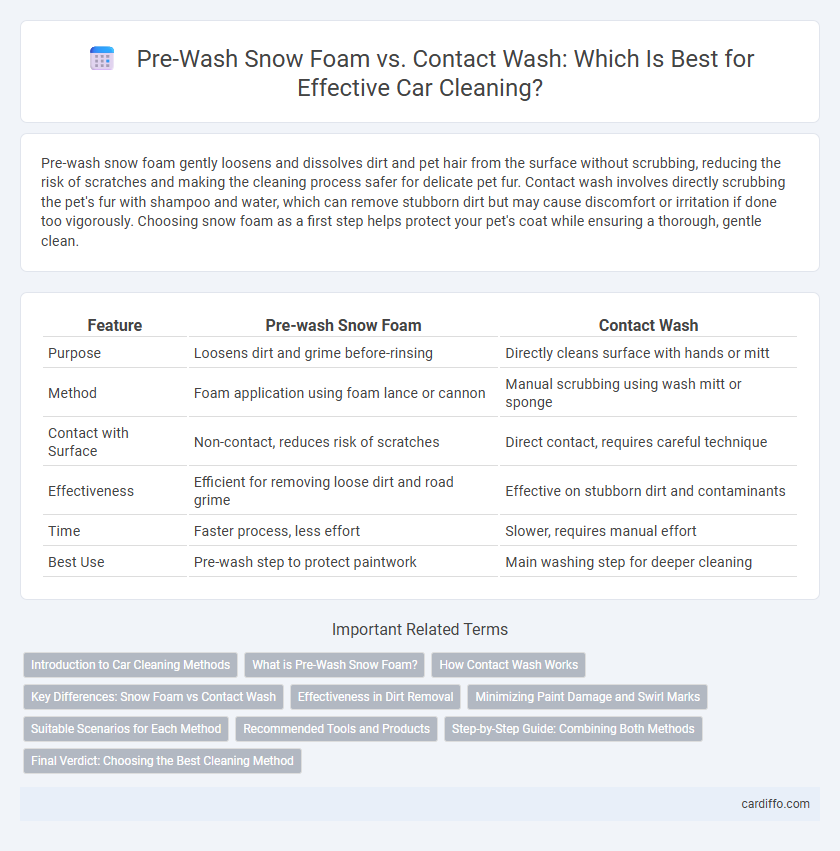Pre-wash snow foam gently loosens and dissolves dirt and pet hair from the surface without scrubbing, reducing the risk of scratches and making the cleaning process safer for delicate pet fur. Contact wash involves directly scrubbing the pet's fur with shampoo and water, which can remove stubborn dirt but may cause discomfort or irritation if done too vigorously. Choosing snow foam as a first step helps protect your pet's coat while ensuring a thorough, gentle clean.
Table of Comparison
| Feature | Pre-wash Snow Foam | Contact Wash |
|---|---|---|
| Purpose | Loosens dirt and grime before-rinsing | Directly cleans surface with hands or mitt |
| Method | Foam application using foam lance or cannon | Manual scrubbing using wash mitt or sponge |
| Contact with Surface | Non-contact, reduces risk of scratches | Direct contact, requires careful technique |
| Effectiveness | Efficient for removing loose dirt and road grime | Effective on stubborn dirt and contaminants |
| Time | Faster process, less effort | Slower, requires manual effort |
| Best Use | Pre-wash step to protect paintwork | Main washing step for deeper cleaning |
Introduction to Car Cleaning Methods
Pre-wash snow foam is a highly effective car cleaning method that loosens and dissolves dirt without physical contact, reducing the risk of scratches and swirl marks on the paint surface. Contact wash involves direct scrubbing with a wash mitt or sponge, allowing for thorough removal of stubborn grime but requiring careful technique to avoid damage. Combining both methods optimizes vehicle cleanliness by ensuring contaminants are safely lifted before manual washing.
What is Pre-Wash Snow Foam?
Pre-wash snow foam is a specialized cleaning product designed to loosen dirt, grime, and contaminants from vehicle surfaces before the actual contact wash. It creates a thick, foamy layer that clings to the paintwork, breaking down stubborn debris and reducing the risk of scratches during washing. Using snow foam as a pre-wash step enhances overall cleaning efficiency by minimizing friction and paint damage when the vehicle is later cleaned with a mitt or sponge.
How Contact Wash Works
Contact wash involves using a soft mitt or sponge to gently remove dirt and grime directly from the vehicle's surface, ensuring thorough cleaning without causing scratches. Unlike snow foam, which encapsulates dirt to loosen it before rinsing, contact wash physically agitates contaminants, providing deeper cleaning effectiveness. This method is crucial for stubborn dirt removal and enhancing the overall quality of the car wash process.
Key Differences: Snow Foam vs Contact Wash
Pre-wash snow foam uses a thick, clinging foam to loosen dirt and grime on a vehicle's surface before rinsing, reducing the risk of scratches during the subsequent wash. Contact wash involves direct physical scrubbing with a sponge or mitt and car shampoo, which can potentially cause swirl marks if contaminants are not fully removed beforehand. Snow foam is ideal for safely breaking down stubborn debris, while contact wash provides a more thorough clean through manual agitation.
Effectiveness in Dirt Removal
Pre-wash snow foam effectively loosens and dissolves stubborn dirt and grime on car surfaces, providing a thorough initial cleanse without physical abrasion. Contact wash involves direct scrubbing with a mitt or sponge, which enhances the removal of remaining dirt particles but risks minor surface scratches if contaminants are present. Combining snow foam pre-wash with a careful contact wash maximizes dirt removal while minimizing paint damage.
Minimizing Paint Damage and Swirl Marks
Pre-wash snow foam creates a thick layer of lubricating foam that loosens dirt and reduces friction, minimizing paint damage and swirl marks during the subsequent wash. Contact wash involves direct physical interaction with the vehicle's surface, increasing the risk of abrasive particles causing micro-scratches and swirls. Using snow foam as a pre-wash step significantly enhances paint protection by ensuring contaminants are safely lifted before any contact occurs.
Suitable Scenarios for Each Method
Pre-wash snow foam excels for heavily soiled vehicles, loosening dirt and grime without direct contact, minimizing the risk of paint scratches before a thorough wash. Contact wash is ideal for regular maintenance on lightly dirty cars, providing precise scrubbing to remove contaminants and restore shine. Using snow foam prior to a contact wash maximizes cleaning efficiency and protection for delicate automotive finishes.
Recommended Tools and Products
Pre-wash snow foam requires a snow foam lance or foam cannon connected to a pressure washer, using pH-neutral or dedicated snow foam detergents that cling to the surface for effective loosening of dirt. Contact wash demands a high-quality wash mitt or microfiber towel paired with a two-bucket system filled with a lubricating car shampoo to minimize abrasion and protect the paintwork. Both methods benefit from using grit guards in buckets and drying with microfiber drying towels to ensure a scratch-free finish.
Step-by-Step Guide: Combining Both Methods
Start by applying a thick layer of pre-wash snow foam using a foam lance, allowing it to dwell for 5-10 minutes to loosen dirt and grime on the vehicle's surface. Follow with a gentle contact wash using a microfiber wash mitt soaked in a pH-balanced car shampoo solution to physically remove remaining contaminants without scratching the paint. Rinse thoroughly with low-pressure water, then dry using a microfiber towel to prevent water spots and preserve the paint's integrity.
Final Verdict: Choosing the Best Cleaning Method
Pre-wash snow foam effectively loosens dirt and grime, reducing the risk of scratches during the subsequent contact wash. Contact wash involves physically touching the vehicle's surface with a sponge or mitt, offering thorough cleaning but requiring proper technique to avoid swirl marks. For optimal results, combining pre-wash snow foam with a careful contact wash provides the best balance of cleanliness and paint protection.
Pre-wash snow foam vs Contact wash Infographic

 cardiffo.com
cardiffo.com